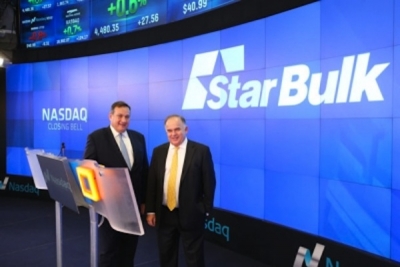Star Bulk hit by $105.2m first half loss on impairment charges

Star Bulk Carriers has been hit by much wider losses due mainly to impairment charges and operating expenses, leading to a first half loss of $105.2m.
The first half net loss widened to $105.2m compared to the loss of $3.87m in the same period of last year.
Operating loss in the first six months escalated to $90.71m compared to only a loss of only $16,000 in the year-ago period due mainly to the combination of an increase in vessel operating expenses as the average number of vessels in the fleet went up to 67.5 from 16.4, lower charter hire rates and a a loss of $13.39m on sale of vessel.
Star Bulk Carriers also reported a vessel impairment loss of $28.8m during the first half, mainly rolled over from the impairment loss of $27.75m registered in the second quarter.
The poor set of first half results followed on from a second quarter loss of $65.02m compared to the deficit of $2.99m in the previous corresponding period, due mainly to the impairment loss and higher operating expenses.
The losses came despite the first half revenue going up to $101.32m from $44.93m due mainly to higher voyage income from the bigger fleet of an average of 67.5 vessel.
The New York-listed dry bulk shipowner had its fleet enlarged after its acquisitions of Oceanbulk and Excel last year.
Amid the weak dry bulk shipping market, Star Bulk saw its second quarter average time charter equivalent rates fell to $8,616 per day from $14,018 per day a year ago.
Petros Pappas, ceo of Star Bulk, commented: “Our (second quarter) bottom line has been affected by non-cash losses of $39.1m related to the sale of four of our on-the-water vessels and one newbuilding vessel under construction, as well as the cancellation of one of our newbuilding vessels.”
The company is now working on easing its newbuilding schedule as it cancelled one newbuilding vessel in the first half, and delayed delivery of its newbuilding vessels for a total of 91 months, corresponding to an average of 4.6 months per vessel. It also disposed of 12 ships since December 2014.
“As far as the long term is concerned, we have seen encouraging steps on the supply side, with high scrapping rates during the first half of 2015, very low new orders and significant delivery slippage,” Pappas said.
“On the demand side, Chinese iron ore import substitution and restocking, Brazilian iron ore production and export expansion, as well as a stabilisation of Chinese coal imports, are expected to assist in driving a sustained recovery of the dry bulk trade demand over the next couple of years,” he added.
HEADLINES
- Do shipping markets want Biden or Trump for the win?
- All 18 crew safe after fire on Japanese-owned tanker off Singapore
- Singapore launching $44m co-investment initiative for maritime tech start-ups
- Cosco debuts Global Shipping Industry Chain Cooperation Initiative
- US warns of more shipping sanctions
- China continues seaport consolidation as Dalian offer goes unconditional